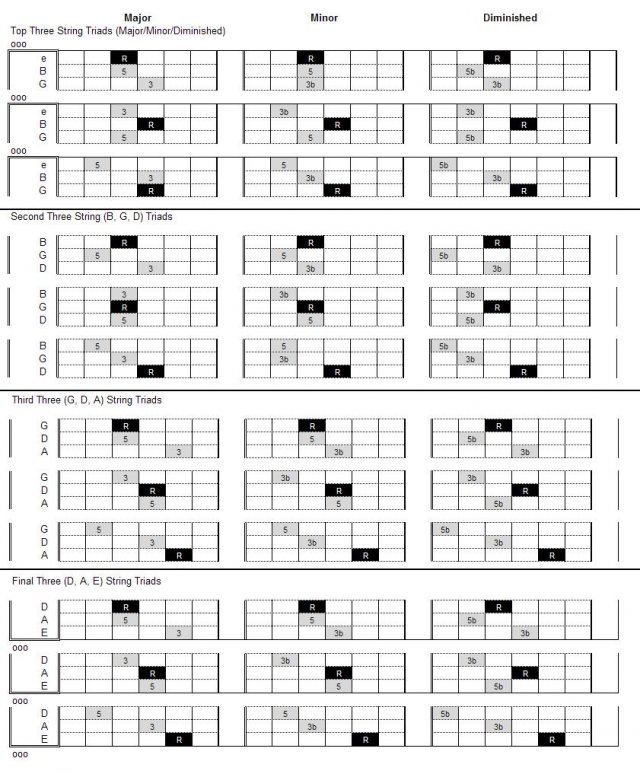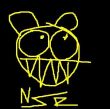| gx1327 |
|
12 Apr 2011 12:42 | Quote |
Joined: 20 Sep 2009 United States  Karma Karma: 9 
|
major, minor, and diminished for use in the diatonic scale. if you need anything else you can plot it out yourself using these stepping stones.
pretty helpful. i've memorized the first 5 sequences (roots on 1st, 2nd, and 3rd string on the first three strings and second three strings)
 |
| btimm |
|
12 Apr 2011 12:46 | Quote |
Joined: 14 Dec 2009 United States  Lessons: 2 Licks: 1 Karma: 16 
|
gx, this should be a lesson imo. Nice format, good work! |
| nullnaught |
|
12 Apr 2011 13:08 | Quote |
Joined: 05 Jun 2010 Karma: 22 
|
Those diminished triads inversions are exactly what i was looking for. Thanks. Excellent lay out. Printed very well. |
| gshredder2112 |
|
12 Apr 2011 13:10 | Quote |
Joined: 03 Sep 2010 United States  Licks: 3 Karma: 22 
|
gx this is indeed amazing.great work! |
| neomass1 |
|
12 Apr 2011 15:45 | Quote |
Joined: 10 Apr 2010 United States  Karma Karma: 11 
|
It would be nice if someone could brake this down for me a bit more, I think I have a basic idea but would like to hear more. |
| gshredder2112 |
|
12 Apr 2011 16:28 | Quote |
Joined: 03 Sep 2010 United States  Licks: 3 Karma: 22 
|
the r means root,3 means third of the roots maj scale,and fifth means 5th note of the maj scale.following the above patterns,starting on an r,you will have a maj triad in the key of the root.same goes for the minor,dimished ect.
so for a simple explaination,learn one pattern,and move it up and down the neck.and the r of that pattern will be the ,triad your playing.for example if you used the above pattern and your root was c,you would have a cmaj triad,if you moved up to c#,and used that as your root,you would have a c# maj triad.maje sense?
gs2112 |
| MoshZilla1016 |
|
12 Apr 2011 16:49 | Quote |
Joined: 10 Jul 2010 United States  Lessons: 4 Licks: 19 Karma: 16 
|
I agree with btimm. This is a good lesson. Combine this with a CAGED lesson and master the fretboard.
@neomass This helps in learning the different locations on the neck to make the same chord. Example: use the 3 Major triads in the top left corner. The root is G, 3rd fret on the e string. the idea is to find two more G triad using the same strings. The next G triad would have the root on the 8th fret B string. The third triads root is on the 12th fret, G string. All the same chord, same strings but 3 different positions. By learning all the triads using 3 different strings (eBG BGD GDA DAE) you will learn 12 ways to make the G triads. I just hope I did not add confusion. |
| nullnaught |
|
12 Apr 2011 19:54 | Quote |
Joined: 05 Jun 2010 Karma: 22 
|
Did you notice that knowing the G D and A string paterns means you automatically know the D A and E string paterns. They are tuned the same. |
| gx1327 |
|
13 Apr 2011 11:17 | Quote |
Joined: 20 Sep 2009 United States  Karma Karma: 9 
|
i did NOT notice that! but it will come in handy when it comes time to learn those strings (i went on a bike adventure yesterday instead of learning my triads)
so my guitar teacher was a little hesitant when he brought up triads. he explained that he has heard some guitarists think that they aren't useful. which i found a little shocking becuase not only was i aware of triads, but i knew a few of them and see them in a LOT of music. specifically i see the upper three string triads in songs that use a light, airy guitar (ska music is a big one but not the only one). after learning all the triads i started recognizing other forms of triads that i've seen in songs that i've learned. very useful, and i'm always interested in learning alternate voicings of chords.
my explanation of triads:
there are a ton of chords out there. major chords, minor chords, dominant 7th chords, add9 chords, etc. but the most basic chords can be broken down into "triads", that is, they consist of three notes. you are probably aware that the major chord consists of the 1-3-5 notes, and the minor has a flattened 3rd consisting of 1-3b-5.
other triads include the diminished triad (1-3b-5b), augmented (1-3-5#), or suspended 2nd/4th (1-2-5, 1-4-5).
for the sake of my practice i started with the chords that make up the major scale progression (the diatonic). I-ii-iii-IV-V-vi-vii*
now you can play a major or a minor chord using a barre chord. that is more than 3 notes, but what you are essentially doing is repeating notes and octaves. when you play a 6-string barre major chord you are actually playing R-5-R-3-5-R. this creates a full sound.
the "triad" breaks that chord down into three components: the root, the 3rd, and the 5th. omit the lower three strings of the major bar chord and now you have 3-5-R --- the major triad.
so knowing your chord shapes and your triads gives you a larger arsenal of "voicings" for your chords. supposedly some teachers don't bother to teach triads, and some students don't see their relevancy. but just from my limited knowledge of popular songs i can play i see them all the time.
of course my teacher gave me a hand-written sheet, but like most guitar notation it's written vertically (with the frets going top to bottom) and i have a hard time reading that. the fretboard is horizontal in my mind, so i made a pretty excel spreadsheet instead. |
|
|







